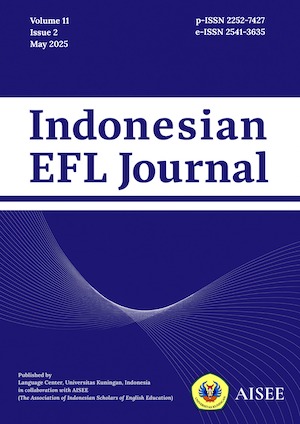UNDERGRADUATE STUDENTS’ PREFERENCE AND PERCEPTIONS ON THE USE OF QUILLBOT AND GRAMMARLY AS PARAPHASING TOOLS
Abstract
Several investigations have studied how using Grammarly and QuillBot as paraphrase tools affects EFL students' writing and attitudes. However, students' preferences regarding these tools for paraphrasing students' writing in Indonesia still seem few and have not been explored much. This research aimed to determine which paraphrasing tools undergraduate students prefer for translating their text. This study used a qualitative case study approach. Questionnaires and in-depth interviews were used to investigate students' preferences as data collection tools. Fifteen students were selected by purposive sampling and were administered an online questionnaire. Then, students participated in in-depth interviews and obtained further information from an online questionnaire. The writer then analyzed the data using frequency and thematic analysis. The findings reveal that students prefer QuillBot over Grammarly for three reasons. First, they consider QuillBot to be an easy-to-access and time-saving tool. Second, QuillBot is a paraphrasing tool with various features that help students to paraphrase their writing. Third, QuillBot helps students avoid plagiarism and keep the originality of their writing. However, Grammarly also received high marks because it uses proper grammar when paraphrasing students' writing. Therefore, combining these two paraphrasing tools will make the students' writing process more efficient and effective.References
Amanda, P., Sukma, E. M., Lubis, N., & Dewi, U. (2023). Quillbot As An AI-powered English Writing Assistant: An Alternative For Students to Write English. Jurnal Pendidikan Dan Sastra Inggris, 3(2), 188–199. https://doi.org/10.55606/jupensi.v3i2.2026
Amyatun, R. L., & Kholis, A. (2023). Can Artificial Intelligence (AI) like QuillBot AI Assist Students’ Writing Skills? Assisting Learning to Write Texts using AI. ELE Reviews: English Language Education Reviews, 3(2), 135–154. https://doi.org/10.22515/elereviews.v3i2.7533
Arizena, M. S., & Mayasari, D. M. (2021). Paraphrasing Strategy in Efl Learners’ Reading Skill. Journal of Business Theory and Practice, 49(1), 66–76. http://www.theseus.fi/handle/10024/341553%0Ahttps://jptam.org/index.php/jptam/article/view/1958%0Ahttp://ejurnal.undana.ac.id/index.php/glory/article/view/4816%0Ahttps://dspace.uii.ac.id/bitstream/handle/123456789/23790/17211077 Tarita Syavira Alicia.pdf?
Ayuningsih, A., Ali, S. W., & Malabar, F. (2020). Faulty parallel structure in students’ argumentative writing. TRANS-KATA: Journal of Language, Literature, Culture and Education, 1(1), 14–21. https://doi.org/10.54923/transkata.v1i1.5
Barrot, J. S. (2022). Integrating Technology into ESL/EFL Writing through Grammarly. RELC Journal, 53(3), 764–768. https://doi.org/10.1177/0033688220966632
Baxter, P., & Jack, S. (2015). Qualitative Case Study Methodology: Study Design and Implementation for Novice Researchers. The Qualitative Report. https://doi.org/https://doi.org/10.46743/2160-3715/2008.1573
Braun, V., & Clarke, V. (2006). Qualitative Research in Psychology Using thematic analysis in psychology Using thematic analysis in psychology. Qualitative Research in Psychology, 3(2), 77–101. http://www.tandfonline.com/action/journalInformation?journalCode=uqrp20%5Cnhttp://www.tandfonline.com/action/journalInformation?journalCode=uqrp20
Chui, H. C. (2022). The QuillBot Grammar Checker: Friend or Foe of ESL Student Writers? Journal of Creative Practices in Language Learning and Teaching (CPLT), 10(1), 2022.
Dewi, U. (2023). Grammarly as Automated Writing Evaluation: Its Effectiveness from EFL Students’ Perceptions. Lingua Cultura, 16(2), 155–161. https://doi.org/10.21512/lc.v16i2.8315
Fitria, T. N. (2021). QuillBot as an online tool: Students’ alternative in paraphrasing and rewriting of English writing. Englisia: Journal of Language, Education, and Humanities, 9(1), 183. https://doi.org/10.22373/ej.v9i1.10233
Fitria, T. N. (2022). Avoiding Plagiarism of Students’ Scientific Writing by Using the QuillBot Paraphraser. Elsya : Journal of English Language Studies, 4(3), 252–262. https://doi.org/10.31849/elsya.v4i3.9917
Ginting, R. S. B., & Fithriani, R. (2022). Peer and Automated Writing Evaluation (Awe): Indonesian Efl College Students’ Preference for Essay Evaluation. LLT Journal: Journal on Language and Language Teaching, 25(2), 461–473. https://doi.org/10.24071/llt.v25i2.4879
Kurniati, E. Y., & Fithriani, R. (2022). Post-Graduate Students’ Perceptions of Quillbot Utilization in English Academic Writing Class. Journal of English Language Teaching and Linguistics, 7(3), 437. https://doi.org/10.21462/jeltl.v7i3.852
Lazic, D., Thompson, A., Pritchard, T., & Tsuji, S. (2020). Student preferences: using Grammarly to help EFL writers with paraphrasing, summarizing, and synthesizing. CALL for Widening Participation: Short Papers from EUROCALL 2020, 2020(2020), 183–189. https://doi.org/10.14705/rpnet.2020.48.1186
Liao, H.-C. (2016). Using Automated Writing Evaluation to Reduce Grammar Errors in Writing. ELT Journal, 70(3), 308–319. https://doi.org/https://doi.org/10.1093/elt/ccv058
Mondal, H., Juhi, A., Dhanvijay, A. D., Pinjar, Mohammed, J., & Mondal, S. (2023). Free Software Applications For Authors For Writing A Research Paper. Journal of Family Medicine and Primary Care, 12(9), 1802–1807. https://doi.org/10.4103/jfmpc.jfmpc_418_23
Nurmayanti, N., & Suryadi, S. (2023). The Effectiveness Of Using Quillbot In Improving Writing For Students Of English Education Study Program. Jurnal Teknologi Pendidikan : Jurnal Penelitian Dan Pengembangan Pembelajaran, 8(1), 32. https://doi.org/10.33394/jtp.v8i1.6392
O’Neill, R., & Russell, A. M. T. (2019). Stop! Grammar time: University students’ perceptions of the automated feedback program Grammarly. Australasian Journal of Educational Technology, 35(1), 42–56. https://doi.org/10.14742/ajet.3795
Sahla, W. A., Mukhlisah, N., Julkawait, J., & Irwansyah, R. (2019). IbM-PELATIHAN TEKNIK PENULISAN PARAFRASE UNTUK SKRIPSI MAHASISWA SEBAGAI UPAYA MENGHINDARI PLAGIARISME. Jurnal IMPACT: Implementation and Action, 1(2), 162. https://doi.org/10.31961/impact.v1i2.645
Syahnaz, M., & Fithriani, R. (2023). Utilizing Artificial Intelligence-based Paraphrasing Tool in EFL Writing Class: A Focus on Indonesian University Students’ Perceptions. Scope : Journal of English Language Teaching, 7(2), 210. https://doi.org/10.30998/scope.v7i2.14882
Wahle, J. P., Ruas, T., Foltýnek, T., Meuschke, N., & Gipp, B. (2022). Identifying Machine-Paraphrased Plagiarism. Lecture Notes in Computer Science (Including Subseries Lecture Notes in Artificial Intelligence and Lecture Notes in Bioinformatics), 13192 LNCS, 393–413. https://doi.org/10.1007/978-3-030-96957-8_34
Winston, J. (2023). Free Paraphrasing Tools You Should Try. Linkedin. https://www.linkedin.com/pulse/top-5-free-paraphrasing-tools-you-should-try-jacob-winston
Xuyen, N. T. (2023). Using the Online Paraphrasing Tool Quillbot to Assist Students in Paraphrasing the Source Information: English-majored Students’ Perceptions. Proceedings of the 5th Conference on Language Teaching and Learning, 2022, 21–27. https://doi.org/10.21467/proceedings.150.3









